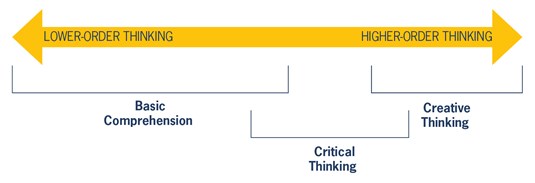In the article on the topic of Critical Thinking in ELT, my co-author Paul Dummett suggested that critical thinking in English language teaching should involve more than simply identifying fact from misinformation or searching texts for supporting evidence. We argue instead that critical thinking is more encompassing and should be viewed as a ‘critical disposition’ (Davis and Barnett, 2015) or as an enquiring mindset towards learning.
To understand this in the context of an ELT lesson, it is useful to see critical thinking in terms of lower- and higher-order thinking so we fully understand its role in our lesson planning. In Bloom’s Taxonomy (Anderson and Krathwohl, 2001), lower-order thinking includes remembering, understanding, and applying. These three processes are fundamental in learning a language. Consider, for example, how a learner learns a new word: by remembering it, understanding what it means, and using or applying it. As language teachers we spend a large amount of time helping our students to achieve this – and rightly so!
However, we can also ask ourselves if it is possible to challenge students and encourage them to use higher order thinking in which they (referring to Bloom’s taxonomy again) analyse, evaluate, and create. In other words, we should encourage students to think both critically and creatively, so they personalize with the new language and ultimately achieve greater learner autonomy.
Paul and I developed the diagram below to show the relationship between lower- and higher-order thinking and how basic comprehension, critical thinking, and creative thinking relate to each other in the classroom.

First of all, it is worth noting that our lower/higher order thinking scale is horizontal. Many other representations of levels of thinking present it vertically, but this seems to suggest lower-order thinking is somehow ‘lesser’ or something to be completed before we can ask students use higher-order thinking. This isn’t true. Knowledge and comprehension are clearly a crucial part of learning and is no way ‘lesser’. Furthermore, thinking in the classroom isn’t a series of steps where we proceed up a scale from lower to higher. In fact, an effective language lesson might begin with a creative thinking task, then involve some comprehension work with a video, followed by a class discussion involving critical thinking. So, the process of thinking is – of course – rarely (if at all) linear.
We also believe that approaching lesson planning with a notion of this lower- and higher-order thinking improves a teacher’s ability to design engaging language tasks at any stage of a lesson. For example, imagine you were going to start a lesson on the topic of ‘Stages in life’ with this image.

Typically, we might begin by asking students to say what they see and to check they have key words (e.g. women, walking stick, bench, mobile phone, etc.). However, we could also consider other types of questions to make greater use of the image and to encourage students to think about it in different ways. Here are some questions we could ask:
For Comprehension:
– Where are the women?
– What are they waiting for?
– What are they doing?
For Critical thinking:
– Can you give the photo a title?
– What does the photo tell us about communication?
– Why do you think the photographer took this photo?
For Creative thinking:
– What do you think the two older women are saying to each other?
– What do you think the younger women is texting?
– Can you write a question for each woman?
As you can see, by thinking about thinking in this way, the teacher goes beyond the basic comprehension tasks that typically fill many lessons and slowly develops the learner’s higher-order thinking skills. Encouraging both critical and creative thinking in this way is a slow process and one that only works by being an everyday part of any lesson, but it seems more principled than simply treating critical thinking as something separate.
In the next article in this series, we’ll start to explore other ways in which this view of critical thinking in the context of lower- and higher-order thinking might be applied to lesson planning and materials design.
To learn more, please see our book Critical Thinking in ELT: a practical model for the classroom from National Geographic Learning.
References
Anderson, L. and Krathwohl, D. (Eds.) (2001) A taxonomy for learning, teaching, and assessing: A revision of Bloom’s taxonomy of educational objectives. London, UK: Pearson.
Davis M & Barnett R (2015) The Palgrave Handbook of Critical Thinking in Higher Education (pp1–26) Basingstoke: Palgrave Macmillan
Dummett, P & Hughes, J (2019) Critical thinking in ELT National Geographic Learning
Hughes, J. (2015) ETpedia Pavilion ELT: Pavilion Publishing


